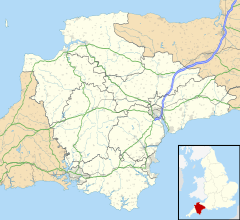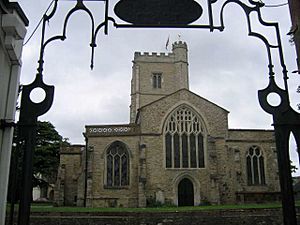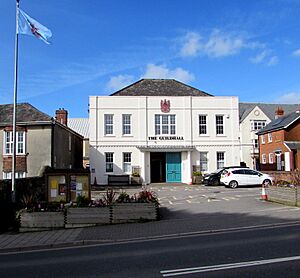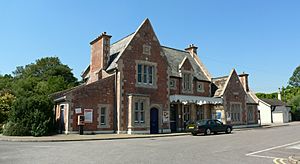Axminster facts for kids
Quick facts for kids Axminster |
|
|---|---|
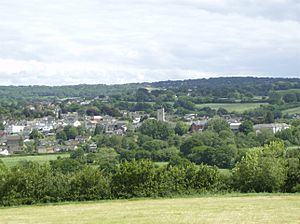 Axminster |
|
 Coat of arms |
|
| Population | 5,761 (2011) |
| OS grid reference | SY2998 |
| Civil parish |
|
| District |
|
| Shire county | |
| Region | |
| Country | England |
| Sovereign state | United Kingdom |
| Post town | AXMINSTER |
| Postcode district | EX13 |
| Dialling code | 01297 |
| Police | Devon and Cornwall |
| Fire | Devon and Somerset |
| Ambulance | South Western |
| EU Parliament | South West England |
| UK Parliament |
|
Axminster is a historic market town in the county of Devon, England. It is located near the eastern border of Devon, about 28 miles (45 km) from Exeter, the county town. The town sits on a hill overlooking the River Axe, which flows into the English Channel at Axmouth. Axminster is part of the East Devon area.
In 2011, the town had a population of 5,761 people. A market is still held every Thursday, continuing a long tradition. Axminster is famous for giving its name to a special type of carpet. These carpets are known for their high quality and many colours. While Axminster Carpets Ltd still makes them in the town, this style of carpet is now made all over the world.
Contents
History of Axminster
Axminster is a very old town, dating back to Celtic times around 300 BC. It was an important place because it was located on two major Roman roads. These included the Fosse Way, which stretched from Lincoln to Seaton, and another road connecting Dorchester to Exeter. There was even a Roman fort nearby at Woodbury Farm. Axminster is one of only 15 British towns shown on an ancient Roman map called the Peutinger Map.
The town's name comes from its location by the River Axe. In the late 800s, it was called Ascanmynster. In the Domesday Book of 1086, it was known as Aixeministra. The name means "monastery or large church by the River Axe." The river's name, Axe, has Celtic roots, and "mynster" is an Old English word for a large church or monastery.
People believe there was once a castle in Axminster, possibly near the current Market Square.
The Famous Carpets
The town's history is closely linked to its carpet industry. This industry began in 1755 when Thomas Whitty started making carpets near the church. Finishing these early hand-made carpets was a huge task. When one was finally done, the church bells would ring to celebrate! Axminster carpets are still made today and have even been used in famous places like Buckingham Palace and Windsor Castle.
Markets and Transport
In 1210, Axminster was given the right to hold a weekly cattle market. This market moved several times over the years. It finally closed in 2006 after the 2001 United Kingdom foot-and-mouth outbreak.
Axminster was also an important stop on the old coaching route from London to Exeter. In 1760, The George Hotel opened, where many coaches would stop each day for people to rest and change horses. The town was also part of The Trafalgar Way, the route used in 1805 to carry news of the Battle of Trafalgar from Falmouth, Cornwall, to London. A plaque in the town centre marks this historic event.
Axminster's railway station opened on 19 July 1860, connecting the town to Exeter and Yeovil. Later, in 1903, a branch line to Lyme Regis was added. This branch line was closed in the 1960s.
During World War II, Axminster was the starting point of the Taunton Stop Line. This was a defensive line of pillboxes (small concrete forts) and anti-tank obstacles built to protect against a possible invasion.
Local Connections
The nearby village of Kilmington was used as a filming location for the 1998 TV show Tess of the d'Urbervilles. The well-known chef and TV presenter Hugh Fearnley-Whittingstall has his "River Cottage HQ" farm in the Axe valley, close to Axminster.
Geography and Nearby Places
The small area of Abbey Gate is just south of the town, near where the A35 and A358 roads meet.
Several villages are located within 5 miles (8 km) of Axminster, including Chardstock, Kilmington, Membury, and Uplyme.
Landmarks to Explore
 Axminster Museum
Axminster Museum Blackdown Hills Area of Outstanding Natural Beauty
Blackdown Hills Area of Outstanding Natural Beauty East Devon Area of Outstanding Natural Beauty
East Devon Area of Outstanding Natural Beauty East Devon Way
East Devon Way Forde Abbey
Forde Abbey Jurassic Coast
Jurassic Coast Lambert's Castle
Lambert's Castle
 Loughwood Meeting House
Loughwood Meeting House Musbury Castle
Musbury Castle
 Shute Barton
Shute Barton
Things to Do in Axminster
Axminster offers several facilities for residents and visitors. These include:
- Cloakham Lawns
- Axe Valley Sports Centre
- Flamingo Swimming Pool
- A local library
- Several churches
- A museum of local history
- Shops, including supermarkets and independent stores.
The Axminster Guildhall is a town building used for various events.
Schools in Axminster
- Axe Valley Academy
- Axminster Community Primary School
- St. Mary's Primary School
- All Saints Community Primary School
Local Media
You can get local news and TV programmes from BBC South West and ITV West Country. Radio stations include BBC Radio Devon, Heart West, Greatest Hits Radio South West, and East Devon Radio. The local newspaper is the Midweek Herald.
Getting Around
Road Travel
Axminster is located where two main roads meet: the A358 (which connects to the A303) and the A35 (from Southampton to Honiton). The A35 now goes around the south of the town on a bypass.
Train Travel
Axminster railway station is on the West of England Main Line. This line connects Exeter to London Waterloo, passing through Salisbury.
Bus Travel
Local bus services connect Axminster to nearby towns and villages like Seaton and Colyton. Longer-distance buses can take you to places like Exeter, Weymouth, Dorchester, and Taunton.
Twin Town
Axminster is twinned with:
- Douvres-la-Délivrande, France
Notable People from Axminster

Many interesting people have connections to Axminster:
- John Prince (1643–1723), a biographer who wrote about famous people from Devon.
- William Buckland (1784–1856), a theologian, geologist, and palaeontologist (someone who studies fossils).
- Clemence Dane (1888–1965), a playwright and novelist.
- Steve Benbow (1931–2006), a folk musician.
- Tyler Dibling (born 2006), a professional footballer.
Freedom of the Town
The "Freedom of the Town" is a special honour given to individuals or military units.
Individuals
- Susan Spiller: January 13, 2022.
- Martin Spurway: November 13, 2023.
Images for kids
See also
 In Spanish: Axminster para niños
In Spanish: Axminster para niños


